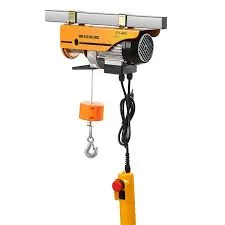


The Future of Chain Block Manufacturers Innovations and Market Trends
In the expansive field of industrial equipment, chain blocks serve as essential lifting devices, facilitating heavy lifting and ensuring safety in a variety of sectors, from construction to manufacturing. As the demand for efficiency and safety rises, chain block manufacturers have begun to adapt by innovating, optimizing production, and exploring new markets. This article delves into the current landscape of chain block manufacturing, highlighting innovations, challenges, and future trends.
Understanding Chain Blocks
Chain blocks, also known as chain hoists, are devices used to lift loads using a chain. They work by wrapping a chain around a wheel, allowing the operator to pull the chain and raise the load. These tools come in various designs and capacities, suitable for different applications. Heavy-duty options can lift tons of weight, essential in manufacturing halls and construction sites, while lighter models are used in warehouses and workshops.
The basic design of chain blocks has remained largely unchanged over the years, but advancements in technology and materials have led to significant improvements in functionality and safety. Today's chain blocks are typically made from durable materials like high-strength steel, which enhances their longevity and reliability.
Innovations in Chain Block Manufacturing
One of the notable innovations in chain block manufacturing is the integration of smart technology. Manufacturers are now incorporating sensors and IoT (Internet of Things) connectivity into chain blocks, allowing for real-time monitoring of load limits, wear and tear, and operational efficiency. This technology not only enhances safety by preventing overloads but also optimizes maintenance schedules, thus reducing downtime.
Moreover, advancements in automation and robotics are shaping the way chain blocks are produced. Automated assembly lines increase precision and efficiency, enabling manufacturers to meet growing demand without compromising on quality. This trend towards automation is expected to continue, making manufacturing processes faster and more consistent.
Additionally, the development of lightweight yet strong materials, such as aluminum alloys and composite materials, has opened the door for more portable and versatile chain blocks. This is particularly beneficial for industries that require mobility in lifting equipment, such as entertainment and event staging.

Market Trends
The global market for chain blocks is witnessing robust growth, driven by expanding industrial activities and construction projects worldwide. The rise of e-commerce has also increased demand for warehouse equipment, including chain blocks, thus providing manufacturers with new opportunities to expand their product lines.
Regionally, Asia-Pacific is a dominant market due to its booming manufacturing sector. Countries such as China, Japan, and India are investing heavily in infrastructure development, which spurs demand for lifting solutions. In response, local manufacturers are focusing on providing high-quality, cost-effective solutions tailored to specific regional needs.
Another trend is the increased emphasis on sustainability. As industries become more environmentally conscious, chain block manufacturers are exploring eco-friendly materials and production processes. This shift not only meets regulatory requirements but also appeals to customers looking for sustainable solutions.
Challenges Ahead
While the future looks promising, chain block manufacturers face several challenges. The rising costs of raw materials can impact pricing strategies and profit margins. Moreover, stringent safety regulations and quality standards necessitate ongoing investment in research and development to ensure compliance.
Additionally, competition from emerging manufacturers, particularly in developing regions, adds pressure on established producers to innovate continuously. As market dynamics shift, the need for manufacturers to remain agile and responsive to changing customer preferences and technological advancements cannot be overstated.
Conclusion
The chain block manufacturing industry stands at a crossroads, characterized by technological advancements, changing market demands, and a push for sustainability. Manufacturers that embrace innovation while maintaining high safety and quality standards will likely emerge as leaders in this competitive landscape. As industries continue to evolve, chain blocks will remain indispensable tools, playing a vital role in ensuring efficient and safe operations across diverse sectors. The future promises an exciting journey for manufacturers willing to adapt and innovate in this dynamic market.



